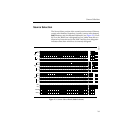
2-16
Section 2 — Control Panel Descriptions
Pressing BKGD A selects background video to change during the
next transition. That is, the background video output of the M/E
will change from the source selected on the A Background bus to
the source selected on the B Background bus.
At the end of the transition, the inputs selected on the background
buses will interchange, or “flip-flop.” The “new video” on the B
Background bus will transfer to the A Background bus, and the
“old video” on the A Background bus will transfer to the B
Background bus.
Activating the KEY 1 or KEY 2 button (lamp lit) causes the next
transition to bring on or remove the selected key. Selecting KEY 1
or KEY 2 delegates the M/E Keyers subpanel and Key bus to the
selected keyer so that the characteristics of that key may be
adjusted (see Keyer subpanel description).
One or both of the KEY buttons can be activated at the same time
and one or both keys can be on (ON indicator lit) at the same time.
Pressing KEY PRIOR causes the next transition to swap the
Key 1/Key 2 priority. This can be performed as a mix, wipe, or cut
transition. Key priority always involves both Key 1 and Key 2
The OVER indicator indicates whether Key 1 is over Key 2, or Key
2 is over Key 1. (The key whose OVER indicator is lit is over the
other key.)
M/E Next Transition Buttons (
Layered Mode
)
In Layered Mode, all of the next transition buttons and indicators
are functional and the LAYERED indicator is lit. In this mode,
BKGD B and BKGD A are keyers.
The transition can affect Background A only, Background B only,
Key 1 only, Key 2 only, Key Priority only, or any combination
thereof. Multiple-layer transitions can be selected by
simultaneously pressing more than one button.
BKGD
A
KEY
1
KEY
2
KEY
PRIOR
OVER
LAYERED


















